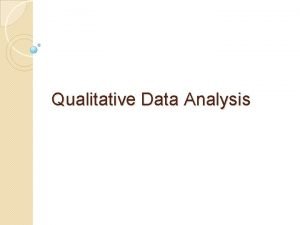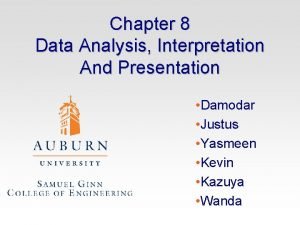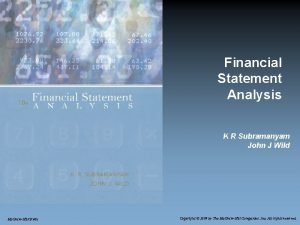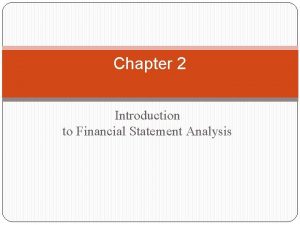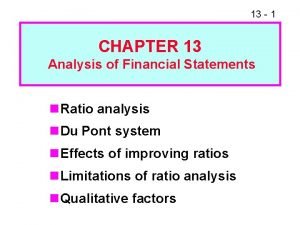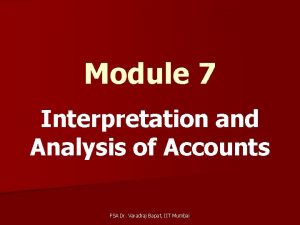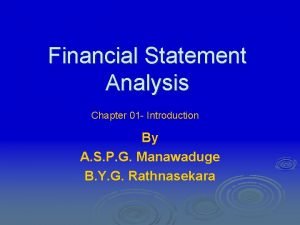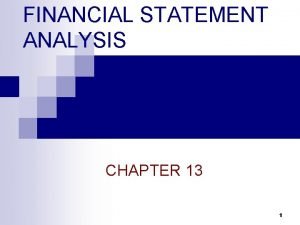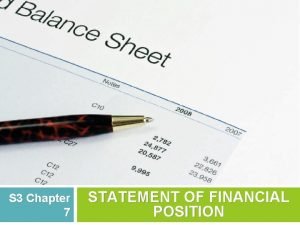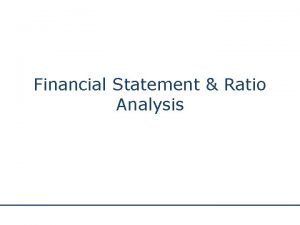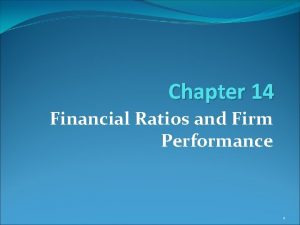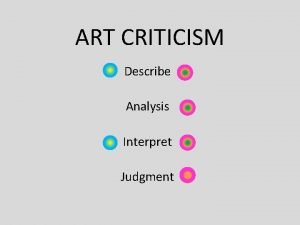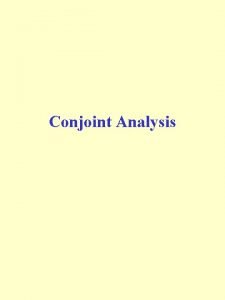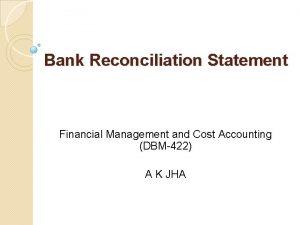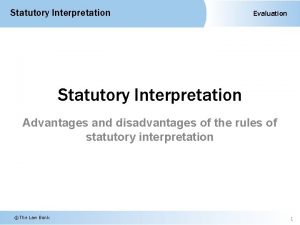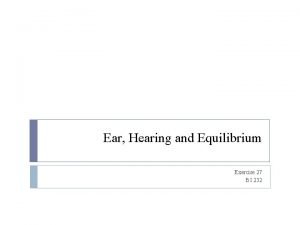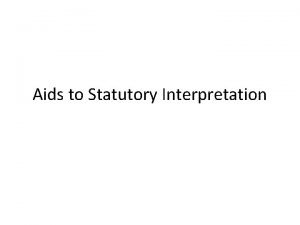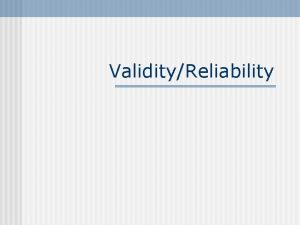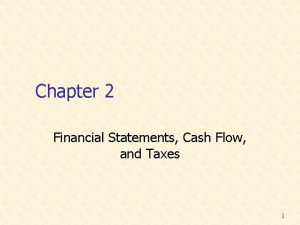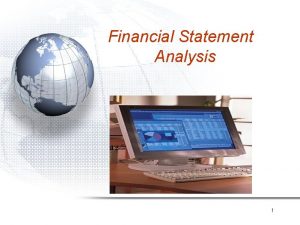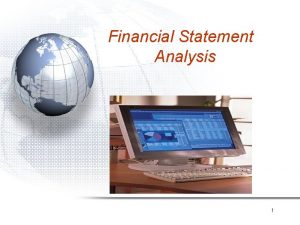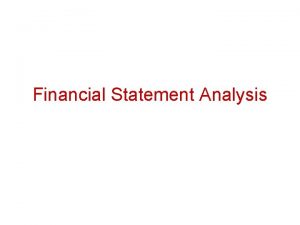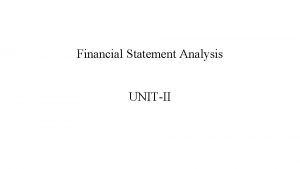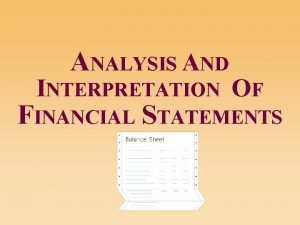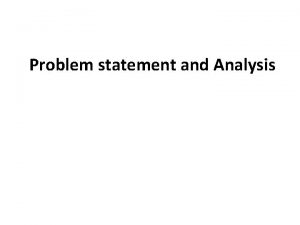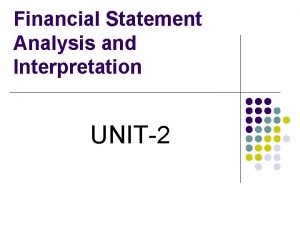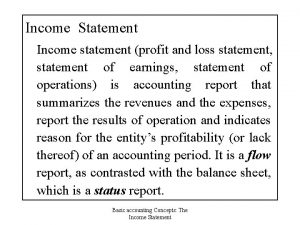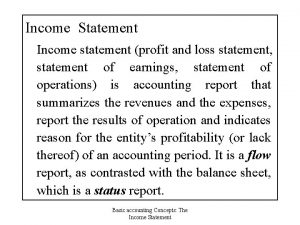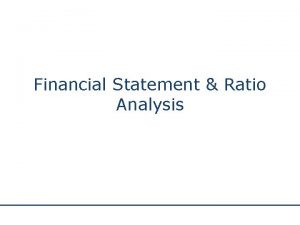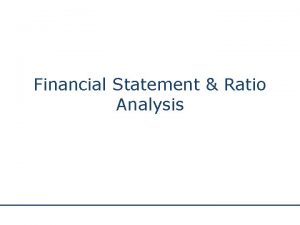Financial statement analysis and interpretation What is financial































































- Slides: 63

Financial statement analysis and interpretation What is financial statement analysis? Examining the financial statements from a users’ perspective and looking at relationships in the accounting information

Financial statement analysis and interpretation Who analyzes financial statements? – Internal users (i. e. , management) – External users (emphasis of chapter) • Examples? • Investors, creditors, regulatory agencies & … • stock market analysts and • auditors

Financial statement analysis and interpretation • What do internal users use it for? Planning, evaluating and controlling company operations • What do external users use it for? Assessing past performance and current financial position and making predictions about the future profitability and solvency of the company as well as evaluating the effectiveness of management

Financial statement analysis and interpretation Information is available from – Published annual reports • • • Financial statements Notes to financial statements Letters to stockholders Auditor’s report (Independent accountants) Management’s discussion and analysis – Reports filed with governments

Financial statement analysis and interpretation Information is available from – Other sources • • Newspapers Periodicals Financial information organizations Other business publications

Methods of financial statement analysis • Horizontal analysis • Vertical analysis • Ratio analysis • Common-size statements • Trend percentages

Horizontal analysis Using comparative financial statements to calculate currency or percentage changes in a financial statement item from one period to the next

Vertical analysis For a single financial statement, each item is expressed as a percentage of a significant total, e. g. , all income statement items are expressed as a percentage of sales

Ratio analysis Expression of logical relationships between items in a financial statement of a single period (e. g. , percentage relationship between revenue and net income)

Common-size statements Financial statements that show only percentages and no absolute currency amounts

Trend percentages Show changes over time in given financial statement items (can help evaluate financial information of several years)

Horizontal analysis example The management of Example Company provides you with comparative balance sheets of the years ended December 31, 2012 and 2011. Management asks you to prepare a horizontal analysis on the information

Horizontal analysis example

Horizontal analysis example Calculating change in currency amounts Money amount change = Current year figure Previous year – figure

Horizontal analysis example Calculating change as a percentage Percentage change = Money amount change Previous year figure × 100%

Horizontal analysis example

Horizontal analysis example (11, 500 ÷ 23, 500) × 100% = 48. 9%

Horizontal analysis example

Horizontal analysis example Let’s apply the same procedures to the liability and stockholders’ equity sections of the balance sheet




Sales increased by 8. 3% while net income decreased by 21. 9%.

There were increases in both cost of goods sold (14. 3%) and operating expenses (2. 1%). These increased costs more than offset the increase in sales, yielding an overall decrease in net income.

Vertical analysis example The management of Sample Company asks you to prepare a vertical analysis for the comparative balance sheets of the company

Vertical analysis example

Vertical Analysis Example 82, 000 ÷ 483, 000 = 17% rounded 30, 000 ÷ 387, 000 = 8% rounded

Vertical analysis example

Vertical analysis example 76, 000 ÷ 483, 000 = 16% rounded

Ratios can be expressed in different ways: 1. Ratio (e. g. , current ratio of 2: 1) 2. % (e. g. , profit margin of 2%) 3. $ (e. g. , EPS of $2. 25) CAUTION! Using ratios and percentages without considering the underlying causes may lead to incorrect conclusions

Categories of ratios • Liquidity ratios Indicate a company’s short-term debt-paying ability • Debt & Equity ratios (Long-term Solvency) Show relationship between debt and equity financing in a company • Profitability ratios & tests Relate income to other variables • Market ratios & tests Help assess relative merits of stocks in the marketplace

Liquidity ratios ¶Current (working capital) ratio ·Quick ratio (‘acid test’) ¸Liquid (cash) ratio ¹Accounts receivable turnover ºNumber of days sales in accounts receivable » Inventory turnover l. Total assets turnover

Debt & Equity ratios (long-term Solvency) ¼Debt to Equity ratio or Debt to TOTAL ‘long term’ funds (D+E) l. Equity ratio (stockholders’ equity)

Profitability ratios & tests ½Return on capital employed ROCE (ie. return on ‘operating assets’ ¾Net income to net sales (return on sales or ‘net profit margin’) ¿Gross profit percentage l. Return on equity ROE (ie. common stockholders equity)

Market ratios & tests l. Earnings per share – Times interest earned – Times preferred dividends earned – Earnings yield on common stock l. Price-earnings ratio – Payout ratio on common stock – Dividend yield on preferred stock – Cash flow per share of common stock

Ratios Now, let’s look at Aspect Corporation’s 2012 and 2011 financial statements




This Information will be used to calculate liquidity ratios for Aspect Co.

Working Capital* The excess of current assets over (ie. minus) current liabilities • While this is not a ratio, it does give an indication of a company’s liquidity

Current ratio Current Ratio = Current Assets Current Liabilities Current Ratio = 65, 000 42, 000 = 1. 55 : 1 Measures the ability of the company to pay current debts as they become due

Quick ratio Quick Ratio Current Assets - Inventory = Current Liabilities = 65, 000 - 12000 = 1. 26 : 1 42, 000 = 53, 000 42, 000 This ratio is often and confusingly also referred to as the “acid-test” = 1. 26 : 1

Liquid (‘acid-test’) ratio Acid-test = ratio Liquid Ratio = Liquid Assets Current Liabilities 30, 000 42, 000 =. 71 : 1 Liquid assets are cash, and current marketable securities

Accounts receivable turnover Average, net accounts receivable Net, credit sales Accounts receivable turnover = Accounts receivable = turnover Sales on Account Average accounts receivable 494, 000 (17, 000 + 20, 000) ÷ 2 This ratio measures how many times a company converts its receivables into cash each year = 26. 70 times

Number of days in accounts receivable days sales in accounts receivables = = 365 Days Accounts receivable turnover 365 days 26. 70 times = 13. 67 days Measures, on average, how many days it takes to collect an account receivable What would be a desirable number of days for collection of accounts receivable ?

Inventory turnover = = Cost of Goods sold Average inventory 140, 000 (10, 000 + 12, 000) ÷ 2 = 12. 73 times Measures the number of times inventory is sold and replaced during the year What would be a desirable number of times for inventory to turnover ?

Debt to Equity, or long–term Solvency ratios This is part of the information to calculate the equity, or long-term solvency ratios of Aspect Corporation

Here is the rest of the information we will use

Debt to Equity ratio Debt to = Equity Long term Debt Total Assets 70, 000 234, 390 Measures the ‘risk’ = 0. 30

Equity ratio Equity = ratio Equity Total assets 234, 390 346, 390 Measures the proportion of total assets provided by stockholders = 67. 7%

Return On Capital Employed ROCE = = ROCE = Earning Before Interest and Tax Equity + Debt (average) PBIT Equity + Debt (average) 76, 700 346, 390 = 22. 1%

Net Income to Net Sales (Return on Sales or Profit Margin) Net Income = to Net Sales net income net sales Net Income = to Net Sales 53, 690 494, 000 = 10. 9% Measures the proportion of the sales dollar which is retained as profit

Return on Equity ROE (return on common stockholders funds) Return on equity funds Return on equity = net income Common equity (average) 53, 690 = (180, 000 + 234, 390) ÷ 2 = 25. 9% Important measure of the income-producing ability of a company

Earnings Per Share Earnings = per Share Earnings Available to Common Stockholders Weighted Average Number of Common Shares Outstanding Earnings 53, 690 = per Share (17, 000 + 27, 400) ÷ 2 = $2. 42 The financial press regularly publishes actual and forecasted EPS amounts

Earnings Per Share • Weighted average calculation Earnings available to common stockholders EPS of common stock = ____________ Weighted average number of common shares outstanding

Earnings Per Share EPS and Stock Dividends or Splits Why restate all prior calculations of EPS? Comparability - i. e. , no additional capital was generated by the dividend or split Basic EPS and Diluted EPS IAS 33

Price-Earnings Ratio ( P/E Multiple ) Price-Earnings = Ratio Market Price Per Share EPS Price-Earnings = Ratio $20. 00 $ 2. 42 = 8. 3 : 1 Provides some measure of whether the stock is under or overpriced

Trend Percentages Example Wheeler, Inc. provides you with the following operating data and asks that you prepare a trend analysis

Trend Percentages Example Wheeler, Inc. provides you with the following operating data and asks that you prepare a trend analysis 1, 991 - 1, 820 = 171

Trend Percentages Example Using 2008 as the base year, we develop the following percentage relationships 1, 991 - 1, 820 = 171 ÷ 1, 820 = 9% rounded

Trend line for Sales

Important Considerations • Need for comparable data – Data is provided by the media etc. – Must compare by industry – Is EPS comparable? • Influence of external factors – General business conditions – Seasonal nature of business operations
 How does interpretation b differ from interpretation a
How does interpretation b differ from interpretation a Financial statement analysis and planning
Financial statement analysis and planning Art criticism interpretation example
Art criticism interpretation example Example of analysis and interpretation of data
Example of analysis and interpretation of data Example of analysis and interpretation of data
Example of analysis and interpretation of data 100 rule linear programming
100 rule linear programming Data presentation and analysis
Data presentation and analysis What is deductive coding
What is deductive coding Data analysis plan
Data analysis plan Nnrims
Nnrims Damodar sessions
Damodar sessions Summary of ratio analysis
Summary of ratio analysis Financial statement analysis subramanyam ppt chapter 2
Financial statement analysis subramanyam ppt chapter 2 Chapter 14 financial statement analysis solutions
Chapter 14 financial statement analysis solutions Financial statement analysis framework
Financial statement analysis framework Chapter 2 financial statement analysis solutions
Chapter 2 financial statement analysis solutions Financial statement analysis objectives
Financial statement analysis objectives Chapter 13 financial statement analysis
Chapter 13 financial statement analysis Horizontal analysis interpretation
Horizontal analysis interpretation Introduction of financial statement analysis
Introduction of financial statement analysis Financial analysis for banks
Financial analysis for banks Solvency investopedia
Solvency investopedia Analysis of financial statements
Analysis of financial statements Limitations of financial statement analysis
Limitations of financial statement analysis Chapter 1 overview of financial statement analysis
Chapter 1 overview of financial statement analysis Tangible net worth
Tangible net worth Chapter 14 financial statement analysis
Chapter 14 financial statement analysis Tga analysis interpretation
Tga analysis interpretation Judgement in art criticism example
Judgement in art criticism example Conjoint analysis spss
Conjoint analysis spss Csf analysis
Csf analysis Financial methods of motivation definition
Financial methods of motivation definition Becker and smith cpas performs a financial statement
Becker and smith cpas performs a financial statement Cost accounting reconciliation statement
Cost accounting reconciliation statement Rationale and statement of the problem
Rationale and statement of the problem Chapter 3 analysis of financial statements
Chapter 3 analysis of financial statements How to improve current ratio
How to improve current ratio Financial analysis planning and forecasting
Financial analysis planning and forecasting Corporate financial reporting and analysis
Corporate financial reporting and analysis Children's apperception test cards ppt
Children's apperception test cards ppt Evolution and interpretation of computer architecture
Evolution and interpretation of computer architecture Disadvantages of literal rule
Disadvantages of literal rule Interpreting topographic maps
Interpreting topographic maps Difference between factor analysis and cluster analysis
Difference between factor analysis and cluster analysis Strict interpretation
Strict interpretation Interpretation and construction
Interpretation and construction Round window reflex
Round window reflex What aberration of nature frightens scout
What aberration of nature frightens scout The role of context in interpretation slideshare
The role of context in interpretation slideshare Tanglefoot stunt
Tanglefoot stunt Intrinsic aids
Intrinsic aids Construct validity
Construct validity Translation and interpretation network
Translation and interpretation network Module 19 visual organization and interpretation
Module 19 visual organization and interpretation Tori's statement of financial position
Tori's statement of financial position Statement of financial position
Statement of financial position Purpose of financial statements
Purpose of financial statements Financial statement robert kiyosaki
Financial statement robert kiyosaki Parents financial statement
Parents financial statement Nature of financial statement
Nature of financial statement Income statement in financial accounting
Income statement in financial accounting Financial statement in millions
Financial statement in millions In-house financial statement
In-house financial statement Report form statement of financial position
Report form statement of financial position







